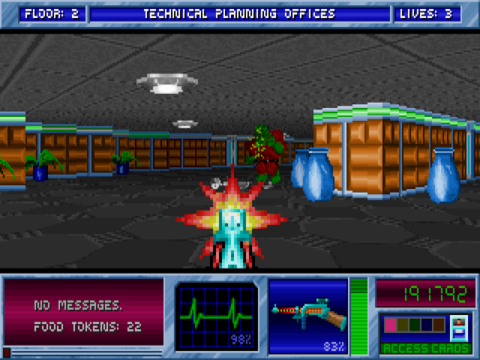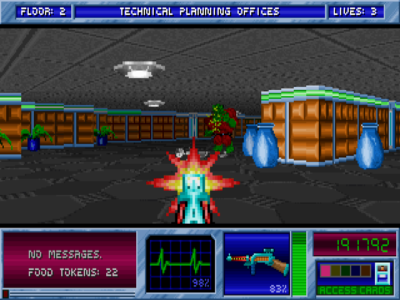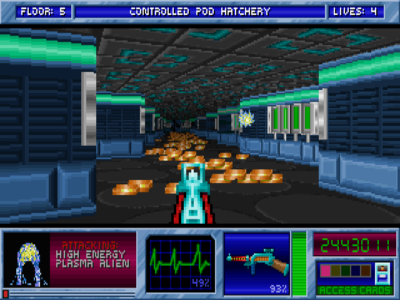
Blake Stone: Aliens of Gold
Written by: Stoo
Date posted: February 21, 2012
- Genre: Action
- Developed by: JAM Productions
- Published by: Apogee
- Year released: 1994
- Our score: 6
So it’s been a few months since I wrote anything here. In fact I’ve only managed a couple of items in half a year. This site has always been a fairly slow-burning project but frankly I should do better. Especially since Rik has more of a life than I do but still manages to churn them out!
I could could drone on about work stress, lack of motivation and the evil allure of MMOs but that’s more the sort of material for livejournal than a topic people come here to read about. Let’s just say that in principle I’m as keen on the oldies as ever, I just need to jolt myself into action. As I was pondering this, I settled on a couple of criteria for next game to tackle. For one, it had to be something easy to pick up and play – no slogging through RPGs just yet. Also, I was in the mood for something properly retro. I wanted VGA and midi-music.
As I thought that a familiar fanfare played in my head – the tune of Apogee Games. I have a lot of love for Apogee, as there’s plenty of old-school action in their back catalogue that I greatly enjoyed back in the day. They made their name around the dawn of the 90s mainly by publishing (and sometimes themselves developing) platformers and the odd scrolling shooter. We’ve covered a couple here like Commander Keen and Cosmo’s Cosmic Adventure.
Then in 1992, they played their part in gaming history, by publishing ID’s Wolfenstein 3D. That is, the game widely acknowledged as establishing the genre known today as the first-person shooter. Apogee would after a few years fix entirely on 3D stuff, mutate into a new form called 3D Realms and give us another classic starring one of PC gaming’s greatest mascots, Duke Nukem. Today tho we’re looking at next shooter released after Wolf3D. Using the same engine, and developed by a little studio called Jam, its aim was to get attention of Wolf3D fans whilst waiting for the next big thing to happen.

Pink guards are fairly dangerous, but green ones are worse.
The plot is of the “press F1 to read if you really care” sort but here goes: It’s 2143. A chap called Doctor Goldfire, brilliant geneticist and owner of a wealthy megacorporation, has gone a bit nuts. By which I mean churning out armies of mutants and genetically modified aliens with which to conquer earth. How do we stop him? Send in a lone hero of course, British secret agent Blake Stone.
In-game, then, most of the limitations of the Wolf3D engine still apply. Actually it’s not really 3D at all, as the levels are totally flat. Also, walls are all at right angles as if drawn on a big grid. So the environments end up feeling rather abstract – lots of rooms and corridors without an obvious purpose. Still the game does at least establish its own look, and the artwork is bright and colorful. You have plush office-type areas, occasionally scattered with potted plants and tables. Also more metallic-ish parts for, I guess, holding the evil gribblies Goldfire is making.
As for enemies, they’re all a bit cartoonish but that suits the feel of the game nicely. So you have big mutant things that go rarwrggg then spew yellow globs at you. Also though human foes that range from mustachioed low-level security guys who might be better off guarding a mall, to bastard soldiers with assault rifles. Your own weapons are basically just guns with variable firing rates, like in Wolfenstein, but at the top end you get some sort of grenade-launcher thing for ammo-guzzling carnage.
The format of the game is again pretty much Wolf3D all over again. Shoot dumb enemies. Roam map looking for keys. Run along walls hammering space until you find a secret. Go to exit and hit a button. So, 90% a reskinned experience. Still to their credit, considering it was a small studio, Jam did code in a bunch of new features along with the new artwork and sound.
First and foremost, an in-game map that updates as you explore a level. Given how labyrinthine some levels can get, and also the fair degree of freedom of movement you get around them, this is hugely helpful. Another little addition is interaction with lab-coated technicians. Some of these are informants and when questioned will give you ammo, health or a clue about the level. The rest, however, aren’t. And about two seconds after you learn this, they will shoot you in the face.
So for my evening’s dose of straightforward blasting, I found that on the mid difficulty setting there was a decent level of challenge. As in, I wasn’t coasting but wasn’t tearing my hair out too much either. (Disclaimer: I never claim to be skilled at any sort of game, so elite types might want to crank it up higher). A few things I quickly learned were, getting shot in the face up close hurts a lot, even when it’s a wimpy foe. Also, enemies with hitscan weapons (basically, modelling bullets with zero travel time as opposed to a projectile you can see in motion) are really hard to dodge. Oh and sound travels, and sometimes I found myself getting attacked from some place behind me that i hadn’t cleared out yet. Okay okay, you might be thinking “duh, Stoo” by now.
So then, I’m not denying this review is to a large extent a nostalgia exercise. I guess this period is one I look back on very fondly.I love the style of the artwork, the spongey-sounding music and the abbreviated sound clips played by enemies (I’m hit!). Also, like Wolf3D it gives you rooms of treasure to grab just for points, to the sound of a chirrup from the FM synthesis chip on your soundcard. Totally incongruous, but a holdover from the platform games that I also fondly recall.
Of course, it is heavily dated. How much we should dwell on that on a site dedicated to old games is arguable, of course. I think some genres age better than others – platformers for example have, perhaps due to what’s a fairly surreal nature when you think about it, a bit of a timeless quality. On the other hand first-person shooters were an attempt at looking like interactions with a realistic environment (even if one with an outlandish theme). That’s something that has progressed over generations, leaving this early generation a long way behind. That’s probably why you can get a load of indie platformers on Steam, but modern hipsters aren’t building new games based on these old raycasting engines.
Also, it’s not a particularly important historical marker. As mentioned it was only ever filler before the next big thing arrived. And that was Doom, the legend of PC gaming that took what Wolf 3D established, improved the technology, added multiplayer and made it a favourite genre. Oh and it arrived a whole month after Blake Stone. So then Jam’s humble effort was rather swiftly trampled on.
Still, even if this is a nostalgia review, it’s not like I totally abandon critical thought. Plenty of times I’ve sat down with some 20-year old item, hoping to relive some sort of childhood experience, and then given up after 10 minutes realising either it’s not that much fun, or it’s going to take some serious effort to get into. I’ve ended up realising I’d rather just watch a Youtube video. This one however provided some solid entertainment. Enough for me to genuinely enjoy playing for a few evenings with a beer or two and NCIS on Channel 5, anyway.
It also still benefits from the Apogee distribution model, whereby the first episode – about ten levels – is distributed as shareware. In other words, free (and legal). You may well find that’s enough. Certainly the full game, at 60-plus maps, is more than enough, given how it really does get quite samey after a while. Then again, wait for the next sale on GoG and you’ll be able to grab it for $3. That feels like good value even for just playing a couple chapters (out of six). And, this is just my view but: even if the Jam guys probably won’t see any of it, I like to pay for oldies when I can. Just to generally support the mission of GoG.com, in making these games so easily available.
So anyway, if you never encountered a first-person shooter before 2000, you might find this hilariously clunky. (but hey, thanks for reading this far). For those of you who were gaming back then, you might enjoy revisiting the formative days of the genre. So go relive some early-90s aesthetics and adlib music. It’s okay to be nostalgic sometimes.




 Posts
Posts
Also available on Steam, separately (http://store.steampowered.com/app/358190/?snr=1_7_15__13) or as part of 3D Realms Anthology (http://store.steampowered.com/sub/61948/) and Apogee Throwback Pack (http://store.steampowered.com/app/238050/?snr=1_7_15__13)
There’s a source port available now so you can play it with modern controls and high res’es and whatnot.
October 19, 2015 @ 4:23 pm